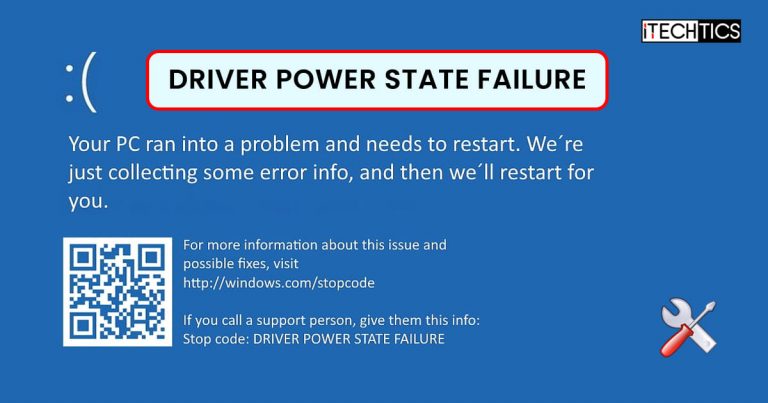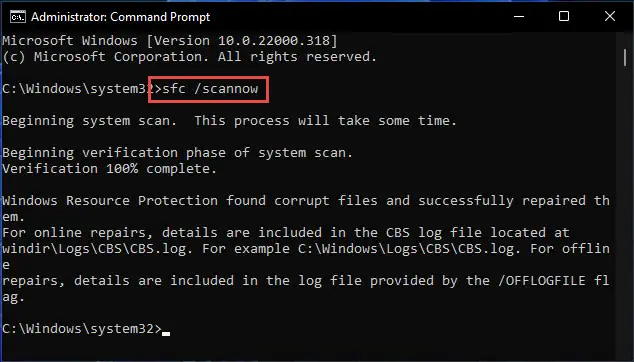Blue Screens of Death (BSoDs) are perhaps one of the scariest events for an IT person.
Thankfully, this error code is one of the easier ones to fix, since part of the cause is already mentioned in the error itself; the “driver.” Most often, this error is caused by a faulty or incompatible driver.
If you have come across this BSoD often, or even once, we recommend that you perform the following set of solutions that will get rid of the issue for good. Whether it is a rare event or happening after every 10 minutes, the possible solutions stated in this post will surely fix it.
Table of Contents
What Causes Driver Power State Failure BSoD
The “Driver Power State Failure” BSoD can be caused due to several reasons. Usually, this is caused because of a Windows driver. The driver can belong to either an integrated device on your computer or to an external device, like a USB flash drive or an external hard drive.
Here is a list of the possible reasons for the “Driver Power State Failure” error:
- An outdated, corrupted, or incompatible driver
- Corrupted operating system files
- Your system has been compromised by a virus
- A third-party antivirus is blocking system files from running, causing the crash
- The display’s power settings aren’t optimized and causing the crash
To address these causes, we have listed down different solutions below in detail in chronological order that you can follow to resolve the issue. After performing each solution, if the error remains, we suggest you move on to the next, more aggressive solution.
Fix Driver Power State Failure Error
Analyze Crash Memory Dump Files
Crash dump files, also known as “mini-dump files,” are system-generated binary files that contain various information about a crash that may have occurred on your computer. Like the Event Viewer, these files can be used to determine the cause of the error, and then use that data to fix it.
We suggest that you begin your investigation by analyzing these files, and maybe you will stumble across the exact culprit causing the “Driver Power State Failure” BSoD.
We have a separate post where you can see how to read and analyze memory dump files, and then use that information to resolve the issue(s).
Once you have the required information, you can continue down to perform the necessary actions.
Update/Reinstall Drivers
The first thing to do after analyzing the dump files is to update your system drivers. If an update isn’t available, then we suggest that you reinstall it.
The following steps guide how to update the display adapter drivers. You can apply the same steps to update the driver determined after analyzing the dump files, or update your network adapter driver since these are usually the ones at fault.
-
Open the Device Manager console by typing in devmgmt.msc in the Run Command box.

Open Device Manager -
Expand Display Adapters, then right-click the GPU under it. From the context menu, click Update Driver.
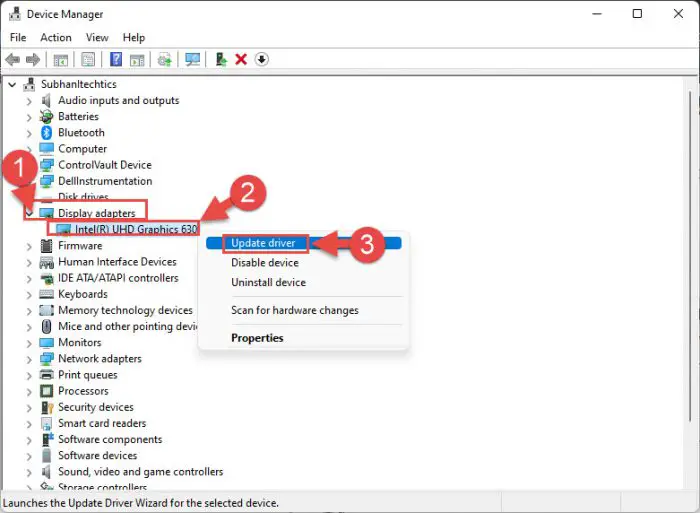
Update GPU driver -
From the update wizard, click “Search automatically for drivers.”
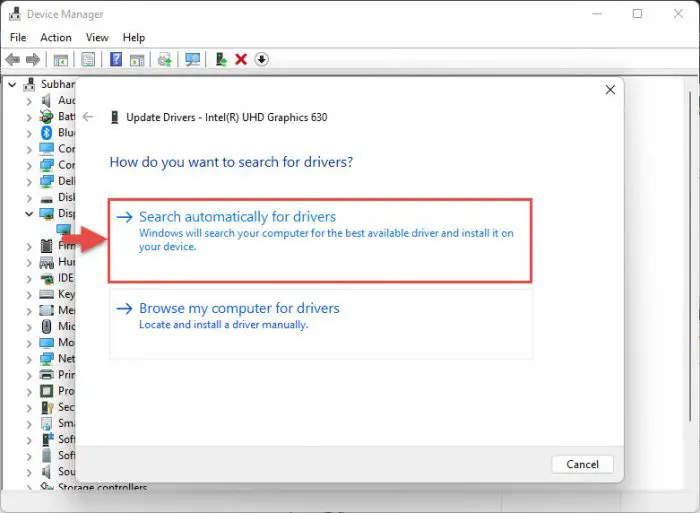
Search automatically The wizard will now search on the web for available drivers and install them.
Note: If a driver is available, then your screen may flicker during the installation process, which is very normal.
-
When the installation finishes, click Close and then restart the computer if required.
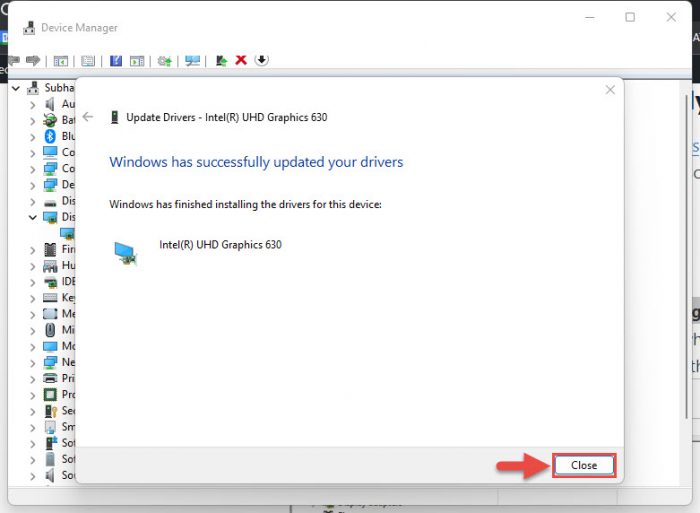
Close wizard
Now check to see if the issue persists.
If the wizard does not find a new driver to install, then you can attempt to fix the issue by reinstalling the current driver version since it might have been corrupted. Here are the steps to reinstall a driver on a Windows computer:
-
Open the Device Manager console by typing in devmgmt.msc in the Run Command box.

Open Device Manager -
Expand Display Adapters, then right-click the GPU under it. From the context menu, click Uninstall Device.
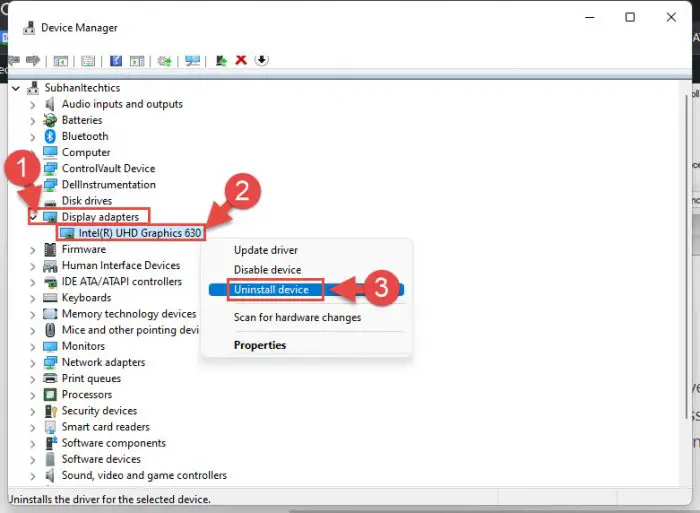
Uninstall GPU driver -
In the confirmation dialog box, check the box next to “Attempt to remove the driver for this device” and then click Uninstall.
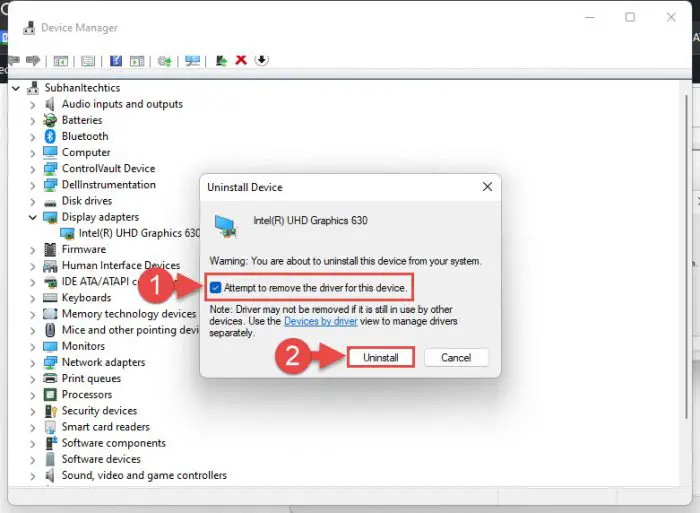
Confirm uninstallation The display driver will now be uninstalled. You may observe some visual changes on your screen, such as flickering, changed resolution and scaling, etc., which is normal.
-
Now click on the “Scan for hardware changes” button at the top so your computer will detect the display adapter again and automatically install the same driver.
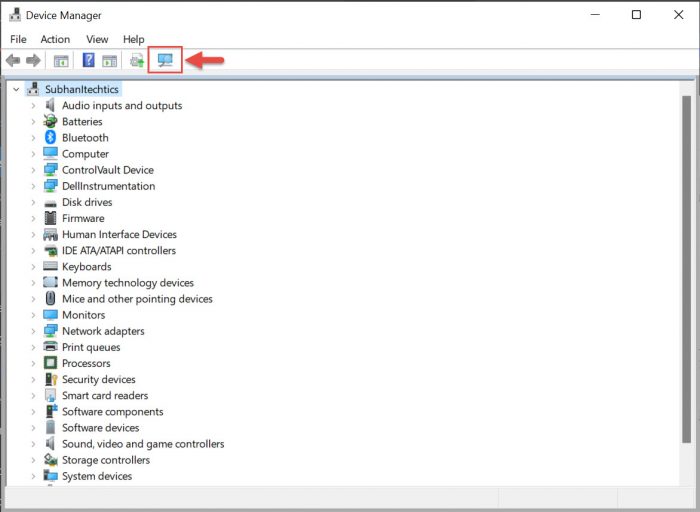
Scan for hardware changes -
Now restart your computer for the changes to take effect.
Once it reboots, check to see if you still see the “Driver Power State Failure” BSoD. If you do, there are still a tonne other solutions you can try out.
Uninstall Recent Software
It may be possible that you experienced this error after installing a piece of software on your PC. It may be a game, a suite, or a tiny tool. However, to troubleshoot the BSoD, you need to uninstall the software and check if it resolved the error.
You can uninstall software on a Windows computer using these steps:
-
Open the Programs and Features applet by typing in appwiz.cpl in the Run Command box.

Open Programs & Features -
Click on the Installed on column header to arrange the apps installed by date in descending order.

Sort by date -
Now right-click on the recently-installed software and then click Uninstall.
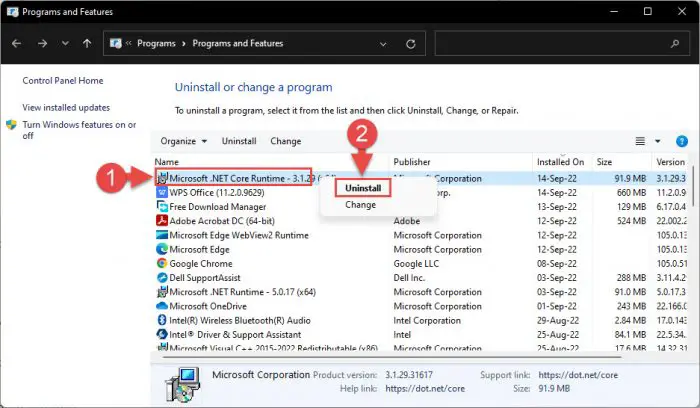
Uninstall software If asked for a confirmation, click Yes.
-
After removing the software, check if you still encounter the “Driver Power State Failure” BSoD. If you do, then repeat the last step to remove all recently-installed software and keep on checking.
If your problem does not go away, continue to mitigate it using other methods listed below.
Run System File Checker
The System File Checker (SFC) is a preinstalled Command Prompt tool in Windows that attempts to repair corrupted system files by replacing them with redundant files. It performs a deep scan of your Windows system files and searches for missing or corrupted content.
Here is how to run the scan:
The cmdlet will then perform its job and attempt to repair any protected system files that may have been corrupted. If so, you shall see the following statement at the end of the scan:
Windows Resource Protection found corrupt files and successfully repaired them.
Now check if you still encounter the same BSoD. If the issue is still unresolved, then you can try another approach.
Verify Driver Integrity
It is important that you have the correct and authentic drivers installed on your system. To do so, you can check their signature and verify that they are in fact from the OEM. This can be done through the File Signature Verification tool that comes preinstalled with Windows. Here is how:
-
Launch the File Signature Verification tool by typing in sigverif in the Run Command box.

sigverif -
From the tool, click Start.

Click Start The tool will now begin scanning your system drives.
-
Once the scan completes, the tool will display the unverified files and drivers. At this point, you need to update or uninstall the drivers listed and then install authentic drivers directly from the OEM.
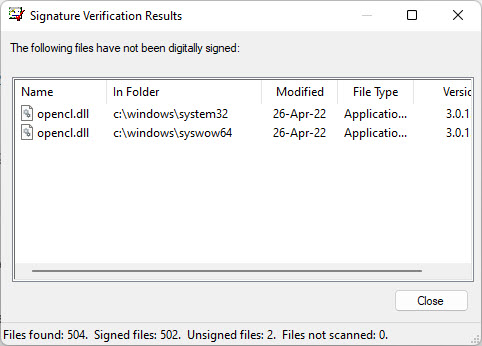
Unverified drivers
Disable Fast Startup, Sleep Mode, and Hibernation
Fast Startup is a Windows feature that controls the shutdown and startup behavior. Fast Startup enables the OS to reload the necessary components while keeping others in the memory, resulting in faster boot times. However, this often negatively affects the different components of the computer and is thus unable to load them properly, including the drivers.
Moreover, the Sleep Mode and hibernation can also cause some components of the computer to not function properly and crash, which is why these need to be disabled to check if it resolves the “Driver Power State Failure” issue:
Here are the steps to disable these features on a Windows PC:
-
Open Power Options by typing in powercfg.cpl in the Run Command box.
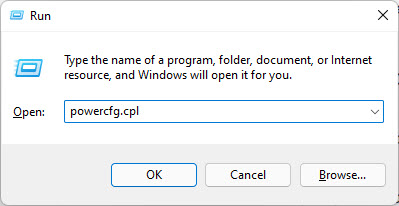
Open Power Options applet -
Click Choose what the power buttons do on the left.
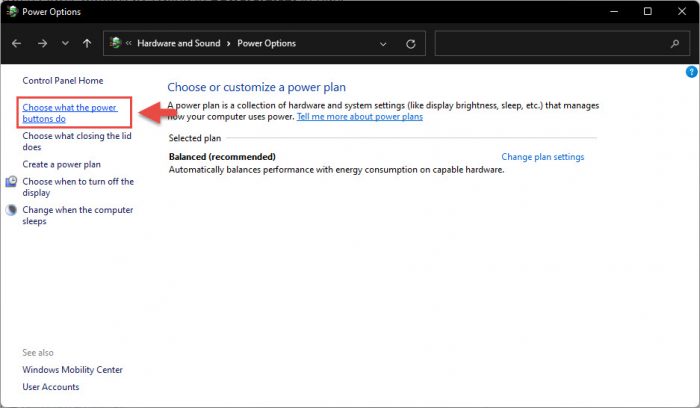
Choose what the power buttons do -
Now click “Change settings that are currently unavailable.”
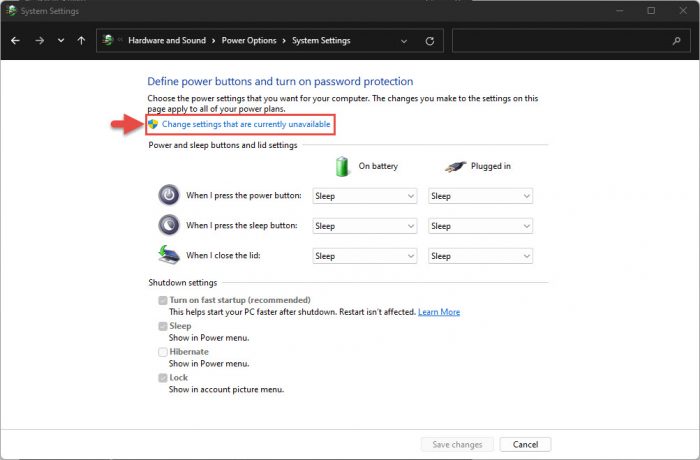
Change unavailable settings -
Now uncheck the boxes next to the following options:
- Turn on fast startup
- Sleep
- Hibernate
Click Save changes when done.

Disable fast startup sleep and hibernate
Note: If you find that these options are not available, it may be possible that you have disabled hibernation. To enable it, run the following cmdlet in the Command Prompt with administrative privileges:
powercfg -h on
After running this cmdlet, re-open the “Choose what the power buttons do” page and the options should now be available.
Now that these options are available, are you still seeing the BSoD? If yes, then continue down and perform some of these other possible solutions.
Disable Power Saving
If you are a laptop user, then it will probably have a power-saving mode. In that case, you need to adjust your power-saving settings and change it to maximum performance. Here is how to do it:
-
Open Power Options by typing in powercfg.cpl in the Run Command box.

Open Power Options -
Click Change plan settings in front of the selected power plan.

Change power plan settings -
Now click Change advanced power settings.
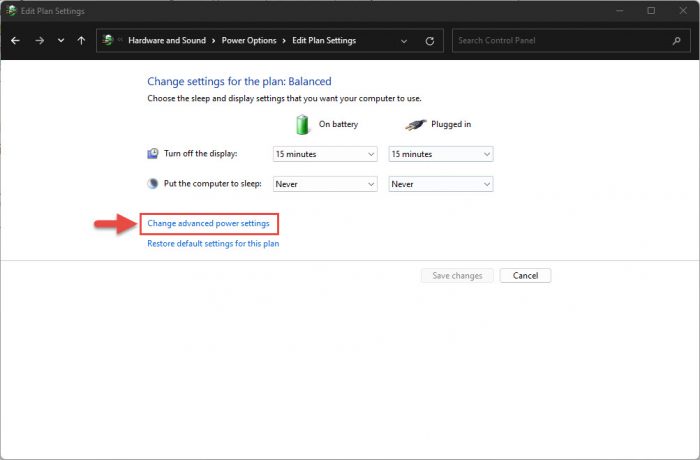
Change advanced power settings -
From the popup window, navigate to Wireless Adapter Settings >> Power Saving Mode. Here, set the “On battery” and “Plugged in” setting to Maximum Performance. Then click Apply and Ok.
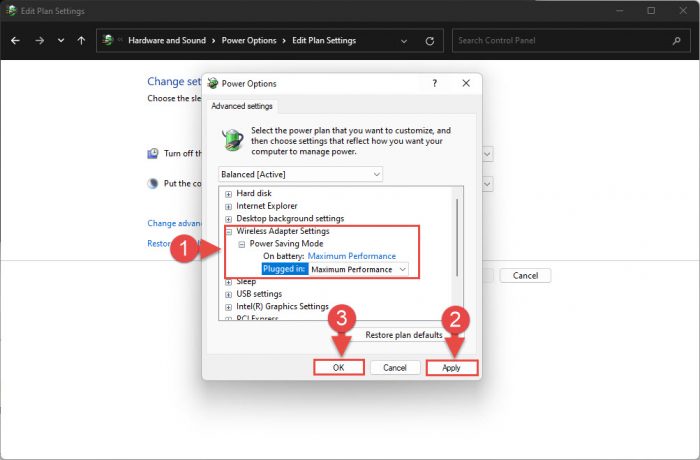
Set power saving mode to maximum performance -
Now restart your computer so that the new settings can be applied.
When it reboots, check if the issue persists.
Uninstall Third-Party Antivirus
All third-party antiviruses cannot be trusted, and even if they are, it is still plausible that they might consider legitimate system files as a threat and block them from running. Therefore, as a last resort, we recommend that you disable or uninstall any third-party software on your PC and then check to see if it resolves the issue.
You can uninstall them from the Programs & Features applet, or use antivirus removal tools to uninstall them and clear all footprints.
If this doesn’t work either, then there is only one last thing you can do.
Reinstall Windows Operating System
If none of these options worked for you, then you are only left with one option: reinstall your operating system. This isn’t an ideal situation, but you are probably left with no other choice since all the possible solutions for the “DRIVER POWER STATE FAILURE” BSoD have already been tried as mentioned above.
You can download Windows operating systems from the links below and then make a bootable USB device to install it:
Final Verdict
Users have reported different reasons for the “Driver Power State Failure” BSoD, hence they had different solutions for it. Let us know which solution worked in your case in the comments below so it would be even more convenient for our audience to apply the fix quickly and save time.

